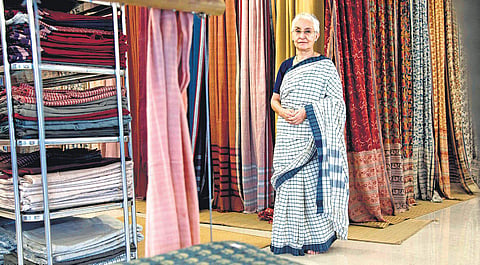

Handloom resuctionist, innovator and founder of the Andhra chapter of Dastkar, Uzramma Bilgrami was 47 years old when she decided that for traditional textile crafts to exist, weavers should be freed from centralisation trap in cotton spinning. Then a homemaker and a trained goldsmith from Britain, and now the ultimate revivalist of the age old local methods of making cotton, time has not dimmed her passion at seventy five. “The love for handlooms and handicraft propels me to do more,” says the elegant silver-haired Hyderabad-based handloom expert.
Her new project is Malkha Marketing Trust for reviving the 5,000-year-old Malkha cotton, which once made India the queen of cotton weaves the world over. The petite sari-clad textile diva says, “When I was working with hand weavers, I realised that getting yarn was a problem for handlooms because yarn is not specifically made for them.” She was so passionate about the arts and handicrafts of her state that she started the NGO, Dastkar Andhra, in 1995.
“It was very tough to make people understand that handlooms need a different kind of yarn from the one used by mills and powerlooms,” says Uzra, who is also credited with starting the Malkha Marketing Trust. “Malkha doesn’t need high maintenance. The fabric becomes softer after each wash and the saris need neither falls nor much ironing. Our team works with our own small-scale spinning mill operators and hand weavers. We do not directly work with cotton farmers, but collaborate with NGOs who do,” she says.
The process explores an alternative to the present situation where small-scale yarn-making units are replacing large-scale spinning mills. Malkha is a form of rural cotton textile industry, which uses local raw material and local skills. “The project envisages a way in which both farmers and weavers benefit from each other, and in which spinning also becomes a rural occupation. It allows people to work near their homes rather than having to move to the ghettos in mill and powerloom textile hubs in urban areas. It empowers rural society socially and politically,” says the soft-spoken Bilgrami.
Malkha eliminates bale-pressing of cotton lint before spinning. Both are damaging to cotton fibre but are part of mainstream cotton yarn spinning.Bilgrami, who studied engraving in goldsmithing in the UK, says, “The idea of Malkha comes from the history of cotton cloth-making in India. Malkha is an attempt—the first in modern history—to make yarn specifically for the handloom, to rid the artisanal textile chain of its dependence on large spinning mills that distort the small-scale, village-based nature of handloom cloth making.”
Malkha fabric has a rustic Indian feel as the weavers use only natural dyes, desi motifs and designs. There are five Malkha centres in Telangana and Andhra Pradesh; more are coming up as demand for Malkha fabrics grows.“It is a joy to see scores of elegant and understated ‘ordinary’ looking saris, kurtas, shirts, yardage and dupattas in the Malkha store. Each piece beckons you to touch and feel them,” says Uzra, who herself wears Malkha saris most of the time.